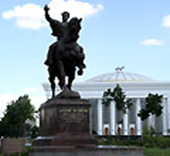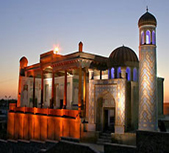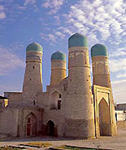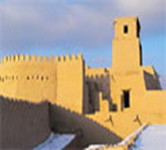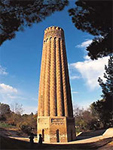History of Tashkent
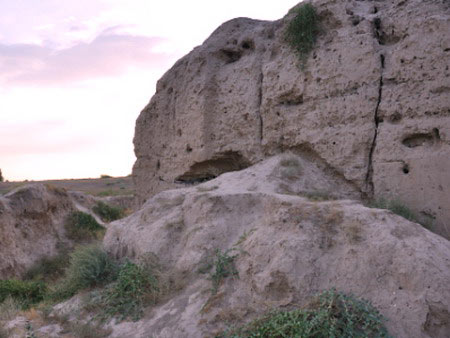 During its long history, Tashkent has had various changes in names and political and religious affiliations.
During its long history, Tashkent has had various changes in names and political and religious affiliations.
Tashkent started as an oasis on the Chirchik River, near the foothills of the West Tian Shan Mountains. In ancient times, this area contained Beitian, probably the summer "capital" of the Kangju confederacy.
In pre-Islamic and early Islamic times the town and the province were known as "Chach". The Shahnameh of Ferdowsi also refers to the city as Chach. Later the town came to be known as Chachkand/Chashkand, meaning "Chach City". The principality of Chach, whose main town had a square citadel built around the 5th to 3rd centuries BC, some 8 kilometres (5.0 mi) south of the Syr Darya River. By the 7th century AD, Chach had over 30 towns and a network of over 50 canals, forming a trade center between the Sogdians and Turkic nomads. The region came under the sway of Islam in the early parts of the 8th century.
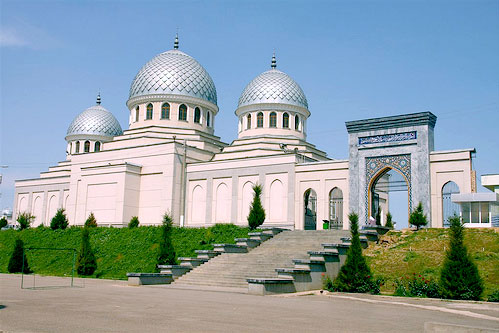 In the mid-seventh century, the Sassanian Persian empire fell to an Arab-lead Islamic conquest. Under the Samanid dynasty (819–999), whose founder Saman Khuda of an Zoroastrian Sassanian Persian had converted to Islam, the city came to be known as Binkath. However, the Arabs retained the old name of Chach for the surrounding region, pronouncing it al-Shash instead. The modern Turkic name of Tashkent (City of Stone) comes from Kara-Khanid rule in the 10th century. (Tash in Turkic languages means stone. Kand, qand, kent —all meaning a city—are derived from the Persian/Sogdian kanda, meaning a town or a city. They are found in city names like Samarkand, Yarkand, Penjikent, Khujand etc.). After the 16th century, the name was steadily changed slightly from Chachkand/Chashkand to Tashkand, which, as "stone city", was more meaningful to the new inhabitants than the old name. The modern spelling of Tashkent reflects Russian orthography.
In the mid-seventh century, the Sassanian Persian empire fell to an Arab-lead Islamic conquest. Under the Samanid dynasty (819–999), whose founder Saman Khuda of an Zoroastrian Sassanian Persian had converted to Islam, the city came to be known as Binkath. However, the Arabs retained the old name of Chach for the surrounding region, pronouncing it al-Shash instead. The modern Turkic name of Tashkent (City of Stone) comes from Kara-Khanid rule in the 10th century. (Tash in Turkic languages means stone. Kand, qand, kent —all meaning a city—are derived from the Persian/Sogdian kanda, meaning a town or a city. They are found in city names like Samarkand, Yarkand, Penjikent, Khujand etc.). After the 16th century, the name was steadily changed slightly from Chachkand/Chashkand to Tashkand, which, as "stone city", was more meaningful to the new inhabitants than the old name. The modern spelling of Tashkent reflects Russian orthography.
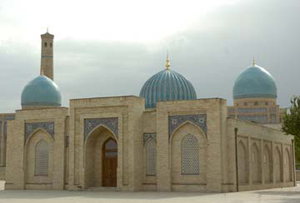 The city was destroyed by Genghis Khan in 1219, although the great conqueror had found that the Khorezmshah had already sacked the city in 1214. Under the Timurids and subsequent Shaybaniddynasties the city revived, despite occasional attacks by the Uzbeks, Kazakhs, Persians, Mongols, Oirats and Kalmyks.
The city was destroyed by Genghis Khan in 1219, although the great conqueror had found that the Khorezmshah had already sacked the city in 1214. Under the Timurids and subsequent Shaybaniddynasties the city revived, despite occasional attacks by the Uzbeks, Kazakhs, Persians, Mongols, Oirats and Kalmyks.
In 1809, Tashkent was annexed to the Khanate of Kokand. At the time, Tashkent had a population of around 100,000 and was considered the richest city in Central Asia. It prospered greatly through trade to Russia, but chafed under Kokand’s high taxes. The Tashkent clergy also favored the clergy of Bukhara over that of Kokand. However, before the Emir of Bukhara could capitalize on this discontent, the Russian army arrived.
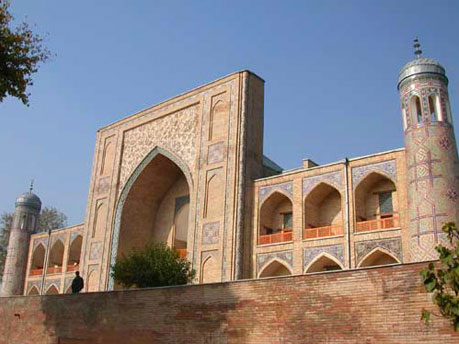 In May, 1865, General Mikhail Chernyayev, acting against the direct orders of the Russian tsar, and outnumbered at least 15-1 staged a daring night attack against a city with a wall 25 kilometres (16 mi) long with 11 gates and 30,000 defenders. While a small contingent staged a diversionary attack, the main force penetrated the walls, led by a Russian Orthodox priest armed only with a crucifix. Although defense was stiff, the Russians captured the city after two days of heavy fighting and the loss of only 25 dead as opposed to several thousand of the defenders (including Alimqul, the ruler of the Kokand Khanate). Chernyayev, dubbed the "Lion of Tashkent" by city elders, staged a "hearts-and-minds" campaign to win the population over. He abolished taxes for a year, rode unarmed through the streets and bazaars meeting common people, and appointed himself "Military Governor of Tashkent", recommending to Tsar Alexander II that the city be made an independent khanate under Russian protection.
In May, 1865, General Mikhail Chernyayev, acting against the direct orders of the Russian tsar, and outnumbered at least 15-1 staged a daring night attack against a city with a wall 25 kilometres (16 mi) long with 11 gates and 30,000 defenders. While a small contingent staged a diversionary attack, the main force penetrated the walls, led by a Russian Orthodox priest armed only with a crucifix. Although defense was stiff, the Russians captured the city after two days of heavy fighting and the loss of only 25 dead as opposed to several thousand of the defenders (including Alimqul, the ruler of the Kokand Khanate). Chernyayev, dubbed the "Lion of Tashkent" by city elders, staged a "hearts-and-minds" campaign to win the population over. He abolished taxes for a year, rode unarmed through the streets and bazaars meeting common people, and appointed himself "Military Governor of Tashkent", recommending to Tsar Alexander II that the city be made an independent khanate under Russian protection.
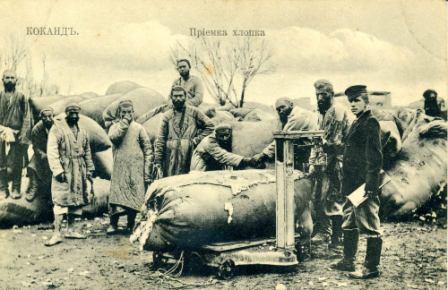 The Tsar liberally rewarded Chernyayev and his men with medals and bonuses, but regarded the impulsive general as a "loose cannon", and soon replaced him with General Konstantin von Kaufman. Far from being granted independence, Tashkent became the capital of the new territory of Russian Turkistan, with Kaufman as first Governor-General. A cantonment and Russian settlement were built across the Ankhor Canal from the old city, and Russian settlers and merchants poured in. Tashkent was a center of espionage in the Great Game rivalry between Russia and the United Kingdom over Central Asia. The Turkestan Military District was established as part of the military reforms of 1874. The Trans-Caspian Railway arrived in 1889, and the railway workers who built it settled in Tashkent as well, bringing with them the seeds of Bolshevik Revolution.
The Tsar liberally rewarded Chernyayev and his men with medals and bonuses, but regarded the impulsive general as a "loose cannon", and soon replaced him with General Konstantin von Kaufman. Far from being granted independence, Tashkent became the capital of the new territory of Russian Turkistan, with Kaufman as first Governor-General. A cantonment and Russian settlement were built across the Ankhor Canal from the old city, and Russian settlers and merchants poured in. Tashkent was a center of espionage in the Great Game rivalry between Russia and the United Kingdom over Central Asia. The Turkestan Military District was established as part of the military reforms of 1874. The Trans-Caspian Railway arrived in 1889, and the railway workers who built it settled in Tashkent as well, bringing with them the seeds of Bolshevik Revolution.
With the fall of the Russian Empire, the Russian Provisional Government removed all civil restrictions based on religion and nationality, contributing to local enthusiasm for the February Revolution. The Tashkent Soviet of Soldiers' and Workers' Deputies was soon set up, but primarily represented Russian residents, who made up about a fifth of the Tashkent population. Muslim leaders quickly set up the Tashkent Muslim Council (Tashkand Shura-yi-Islamiya) based in the old city. On 10 March 1917, there was a parade with Russian workers marching with red flags, Russian soldiers singing the La Marseillaise and thousands of local Central Asians. Following various speeches, Governor-General Aleksey Kuropatkin closed the vents with words "Long Live a great free Russia". Like the Muslim Council this was dominated by the Jadid, Muslim reformers. However, a more conservative faction emerged in Tashkent centered around the Ulema. This faction proved more successful during the local elections of July 1917. They formed an alliance with Russian conservatives, while the Soviet became more radical. The Soviet attempt to seize power in September 1917 proved unsuccessful.
In April 1918, Tashkent became the capital of the Turkestan Autonomous Soviet Socialist Republic (Turkestan ASSR). The new regime was threatened by White forces, “basmachi”, revolts from within, and purges ordered from Moscow. Tashkent fell within the borders of the Uzbek SSR, and became the capital of the Uzbek SSR in 1930, displacing Samarkand.
The city began to industrialize in the 1920s and 1930s, but industry increased tremendously during World War II, with the relocation of factories from western Russia to preserve the Soviet industrial capacity from the invading Nazis. The Russian population increased dramatically as well, with evacuees from the war zones increasing the population to well over a million. The Russians and Ukrainians would eventually comprise more than half of the total residents of Tashkent.
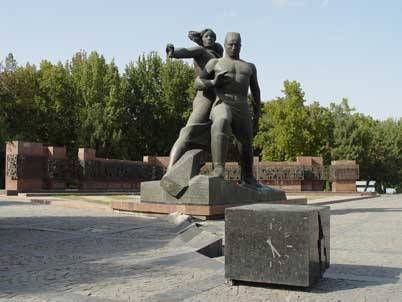 On 26 April 1966, Tashkent was destroyed by a huge earthquake (7.5 on the Richter scale) and over 300,000 were left homeless. Some 78,000 poorly engineered homes were destroyed mainly in the densely packed areas of the old city where traditional adobe housing predominated. The Soviet republics and some other countries such as Finland sent "battalions of fraternal peoples” and urban planners to help rebuild devastated Tashkent. They created a “model Soviet city” of wide shady streets, parks, immense plazas for military parades, fountains, monuments, and acres of apartment blocks. About 100,000 new homes were built by 1970, many of which were filled with the families of the builders. Further development in the following years increased the size of the city with major new developments in the Chilonzar area, north-east and south-east of the city.
On 26 April 1966, Tashkent was destroyed by a huge earthquake (7.5 on the Richter scale) and over 300,000 were left homeless. Some 78,000 poorly engineered homes were destroyed mainly in the densely packed areas of the old city where traditional adobe housing predominated. The Soviet republics and some other countries such as Finland sent "battalions of fraternal peoples” and urban planners to help rebuild devastated Tashkent. They created a “model Soviet city” of wide shady streets, parks, immense plazas for military parades, fountains, monuments, and acres of apartment blocks. About 100,000 new homes were built by 1970, many of which were filled with the families of the builders. Further development in the following years increased the size of the city with major new developments in the Chilonzar area, north-east and south-east of the city.
At the time of the collapse of the Soviet Union in 1991, Tashkent was the fourth largest city in the country and a center of learning in the science and engineering fields.
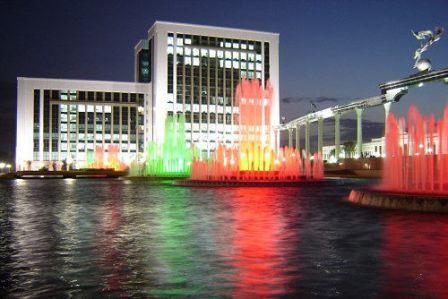 With the 1966 earthquake and the Soviet redevelopment afterward, very little is left of Tashkent's ancient history, including its significance as a trading point on the historic Silk Road.
With the 1966 earthquake and the Soviet redevelopment afterward, very little is left of Tashkent's ancient history, including its significance as a trading point on the historic Silk Road.
At the moment, Tashkent is the most cosmopolitan city in Uzbekistan. The city is noted for its tree lined streets, numerous fountains, and pleasant parks. Since 1991, the city has changed economically, culturally, and architecturally. In 2007, Tashkent was named the cultural capital of the Islamic world as the city is home to numerous historic mosques and Islamic locations of interest. Tashkent also houses the earliest written Qur'an which has been in Tashkent since 1924.
Sights of Tashkent
Where else can you go to Tashkent?
« Назад
 During its long history, Tashkent has had various changes in names and political and religious affiliations.
During its long history, Tashkent has had various changes in names and political and religious affiliations. In the mid-seventh century, the Sassanian Persian empire fell to an Arab-lead Islamic conquest. Under the Samanid dynasty (819–999), whose founder Saman Khuda of an Zoroastrian Sassanian Persian had converted to Islam, the city came to be known as Binkath. However, the Arabs retained the old name of Chach for the surrounding region, pronouncing it al-Shash instead. The modern Turkic name of Tashkent (City of Stone) comes from Kara-Khanid rule in the 10th century. (Tash in Turkic languages means stone. Kand, qand, kent —all meaning a city—are derived from the Persian/Sogdian kanda, meaning a town or a city. They are found in city names like Samarkand, Yarkand, Penjikent, Khujand etc.). After the 16th century, the name was steadily changed slightly from Chachkand/Chashkand to Tashkand, which, as "stone city", was more meaningful to the new inhabitants than the old name. The modern spelling of Tashkent reflects Russian orthography.
In the mid-seventh century, the Sassanian Persian empire fell to an Arab-lead Islamic conquest. Under the Samanid dynasty (819–999), whose founder Saman Khuda of an Zoroastrian Sassanian Persian had converted to Islam, the city came to be known as Binkath. However, the Arabs retained the old name of Chach for the surrounding region, pronouncing it al-Shash instead. The modern Turkic name of Tashkent (City of Stone) comes from Kara-Khanid rule in the 10th century. (Tash in Turkic languages means stone. Kand, qand, kent —all meaning a city—are derived from the Persian/Sogdian kanda, meaning a town or a city. They are found in city names like Samarkand, Yarkand, Penjikent, Khujand etc.). After the 16th century, the name was steadily changed slightly from Chachkand/Chashkand to Tashkand, which, as "stone city", was more meaningful to the new inhabitants than the old name. The modern spelling of Tashkent reflects Russian orthography. The city was destroyed by Genghis Khan in 1219, although the great conqueror had found that the Khorezmshah had already sacked the city in 1214. Under the Timurids and subsequent Shaybaniddynasties the city revived, despite occasional attacks by the Uzbeks, Kazakhs, Persians, Mongols, Oirats
The city was destroyed by Genghis Khan in 1219, although the great conqueror had found that the Khorezmshah had already sacked the city in 1214. Under the Timurids and subsequent Shaybaniddynasties the city revived, despite occasional attacks by the Uzbeks, Kazakhs, Persians, Mongols, Oirats In May, 1865, General Mikhail Chernyayev, acting against the direct orders of the Russian tsar, and outnumbered at least 15-1 staged a daring night attack against a city with a wall 25 kilometres (16 mi) long with 11 gates and 30,000 defenders. While a small contingent staged a diversionary attack, the main force penetrated the walls, led by a Russian Orthodox priest armed only with a crucifix. Although defense was stiff, the Russians captured the city after two days of heavy fighting and the loss of only 25 dead as opposed to several thousand of the defenders (including Alimqul, the ruler of the Kokand Khanate). Chernyayev, dubbed the "Lion of Tashkent" by city elders, staged a "hearts-and-minds" campaign to win the population over. He abolished taxes for a year, rode unarmed through the streets and bazaars meeting common people, and appointed himself "Military Governor of Tashkent", recommending to Tsar Alexander II that the city be made an independent khanate under Russian protection.
In May, 1865, General Mikhail Chernyayev, acting against the direct orders of the Russian tsar, and outnumbered at least 15-1 staged a daring night attack against a city with a wall 25 kilometres (16 mi) long with 11 gates and 30,000 defenders. While a small contingent staged a diversionary attack, the main force penetrated the walls, led by a Russian Orthodox priest armed only with a crucifix. Although defense was stiff, the Russians captured the city after two days of heavy fighting and the loss of only 25 dead as opposed to several thousand of the defenders (including Alimqul, the ruler of the Kokand Khanate). Chernyayev, dubbed the "Lion of Tashkent" by city elders, staged a "hearts-and-minds" campaign to win the population over. He abolished taxes for a year, rode unarmed through the streets and bazaars meeting common people, and appointed himself "Military Governor of Tashkent", recommending to Tsar Alexander II that the city be made an independent khanate under Russian protection. The Tsar liberally rewarded Chernyayev and his men with medals and bonuses, but regarded the impulsive general as a "loose cannon", and soon replaced him with General Konstantin von Kaufman. Far from being granted independence, Tashkent became the capital of the new territory of Russian Turkistan, with Kaufman as first Governor-General. A cantonment and Russian settlement were built across the Ankhor Canal from the old city, and Russian settlers and merchants poured in. Tashkent was a center of espionage in the Great Game rivalry between Russia and the United Kingdom over Central Asia. The Turkestan Military District was established as part of the military reforms of 1874. The Trans-Caspian Railway arrived in 1889, and the railway workers who built it settled in Tashkent as well, bringing with them the seeds of Bolshevik Revolution.
The Tsar liberally rewarded Chernyayev and his men with medals and bonuses, but regarded the impulsive general as a "loose cannon", and soon replaced him with General Konstantin von Kaufman. Far from being granted independence, Tashkent became the capital of the new territory of Russian Turkistan, with Kaufman as first Governor-General. A cantonment and Russian settlement were built across the Ankhor Canal from the old city, and Russian settlers and merchants poured in. Tashkent was a center of espionage in the Great Game rivalry between Russia and the United Kingdom over Central Asia. The Turkestan Military District was established as part of the military reforms of 1874. The Trans-Caspian Railway arrived in 1889, and the railway workers who built it settled in Tashkent as well, bringing with them the seeds of Bolshevik Revolution. On 26 April 1966, Tashkent was destroyed by a huge earthquake (7.5 on the Richter scale) and over 300,000 were left homeless. Some 78,000 poorly engineered homes were destroyed mainly in the densely packed areas of the old city where traditional adobe housing predominated. The Soviet republics and some other countries such as Finland sent "battalions of fraternal peoples” and urban planners to help rebuild devastated Tashkent. They created a “model Soviet city” of wide shady streets, parks, immense plazas for military parades, fountains, monuments, and acres of apartment blocks. About 100,000 new homes were built by 1970, many of which were filled with the families of the builders. Further development in the following years increased the size of the city with major new developments in the Chilonzar area, north-east and south-east of the city.
On 26 April 1966, Tashkent was destroyed by a huge earthquake (7.5 on the Richter scale) and over 300,000 were left homeless. Some 78,000 poorly engineered homes were destroyed mainly in the densely packed areas of the old city where traditional adobe housing predominated. The Soviet republics and some other countries such as Finland sent "battalions of fraternal peoples” and urban planners to help rebuild devastated Tashkent. They created a “model Soviet city” of wide shady streets, parks, immense plazas for military parades, fountains, monuments, and acres of apartment blocks. About 100,000 new homes were built by 1970, many of which were filled with the families of the builders. Further development in the following years increased the size of the city with major new developments in the Chilonzar area, north-east and south-east of the city.  With the 1966 earthquake and the Soviet redevelopment afterward, very little is left of Tashkent's ancient history, including its significance as a trading point on the historic Silk Road.
With the 1966 earthquake and the Soviet redevelopment afterward, very little is left of Tashkent's ancient history, including its significance as a trading point on the historic Silk Road.